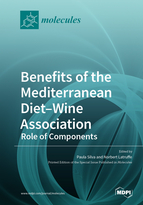Benefits of the Mediterranean Diet–Wine Association: Role of Components
A special issue of Molecules (ISSN 1420-3049). This special issue belongs to the section "Natural Products Chemistry".
Deadline for manuscript submissions: closed (30 September 2021) | Viewed by 49424
Special Issue Editors
Interests: Mediterranean diet; wine; olive oil; foods; nutrients; phytochemicals; polyphenols; bioactive compounds; lifestyle patterns; sustainable agriculture; wine marketing; wine tourism; sustainable wine tourism and tourist motivation; sustainable agri-food chain; science communication
Special Issues, Collections and Topics in MDPI journals
Interests: bio-active polyphenols; resveratrol; inflammation; bio-availability; cancer; pathologies prevention
Special Issues, Collections and Topics in MDPI journals
Special Issue Information
Dear Colleagues,
The Mediterranean diet is a model of eating based on the traditional foods and drinks of the countries surrounding the Mediterranean Sea. In recent decades, it has been promoted worldwide as one of the healthiest dietary patterns and has been reported to have benefits regarding chronic diseases and longevity. The Mediterranean diet encourages moderated consumption of wine. However, many consumers do not know what to think about the health effects of drinking wine. Moderate drinking has been associated to health benefits by some researchers, especially to the richness of wine in anti-oxidant. Others, on the other hand, claim that even the occasional drink is harmful to health.
The creation of a Molecules Special Issue which focuses on the Role of Wine Components in the Mediterranean Diet Benefits would be a good opportunity to support this concept. Any manuscripts related to polyphenols; resveratrol; aging; antioxidant; wine; health; the Mediterranean diet; nutrition; diseases; welfare; behavior; etc. at the level of mechanisms, analysis, and experimental and epidemiological studies are welcome.
Please note that the clarification of this issue was what motivated Science & Wine to promote Conference on “Wine Consumption in the Mediterranean Diet: A clarification about health effects” be held in Porto on 4–5 June 2020, https://www.science-and-wine-conferences.com
Prof. Dr. Paula Silva
Prof. Dr. Norbert Latruffe
Guest Editors
Manuscript Submission Information
Manuscripts should be submitted online at www.mdpi.com by registering and logging in to this website. Once you are registered, click here to go to the submission form. Manuscripts can be submitted until the deadline. All submissions that pass pre-check are peer-reviewed. Accepted papers will be published continuously in the journal (as soon as accepted) and will be listed together on the special issue website. Research articles, review articles as well as short communications are invited. For planned papers, a title and short abstract (about 100 words) can be sent to the Editorial Office for announcement on this website.
Submitted manuscripts should not have been published previously, nor be under consideration for publication elsewhere (except conference proceedings papers). All manuscripts are thoroughly refereed through a single-blind peer-review process. A guide for authors and other relevant information for submission of manuscripts is available on the Instructions for Authors page. Molecules is an international peer-reviewed open access semimonthly journal published by MDPI.
Please visit the Instructions for Authors page before submitting a manuscript. The Article Processing Charge (APC) for publication in this open access journal is 2700 CHF (Swiss Francs). Submitted papers should be well formatted and use good English. Authors may use MDPI's English editing service prior to publication or during author revisions.
Keywords
- Polyphenols
- Wine
- Mediterranean diet
- Flavonoids
- Public health policy
- Healthy lifestyle
- Mediterranean countries
- Health communication
- Nutrition
- Welfare
- Culture heritage








